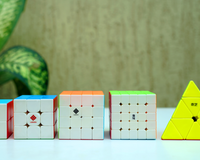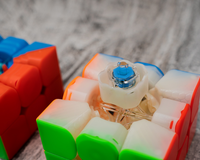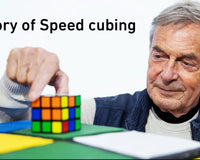What are Cube Lubricants
Almost everyone in the cubing community uses cube lubricants of some sort. But what are they? Well, cube lubricants are basically a way to make your cube faster or slower, depending on which cube you use. Cube lubricants allow you to have more control over how a cube feels like. If you prefer slower and more controllable cubes, you can get that feel by using a heavy lubricant whereas if you want a really fast cube, you can get that feel by using a light and watery lubricant. Now let’s get to why we use lubricants!
Why Do We Use Lubricants?
There are a lot of uses for lubricants. Lubricants delay the ever so slight wear and tear of the cube that can be caused by doing a lot of solves. Dry cubes tend to get more affected by friction and the plastic wears off and the quality of the puzzle deteriorates. Lubricants prevent all of that and provide an extra layer in between the pieces rubbing against each other, reduce friction by removing the dryness, and ensure that your cube is gonna last long! Lubricants also have a lot of other perks as well, so let’s discuss them!

Tensioning
Lubricants can be used to make your cube super fast almost instantly. This is extremely useful in competition scenarios, where you need the best performance possible. Loosening the tensions is also an option, but it makes the cube more prone to pops, especially in bigger cubes like 4x4 and 5x5.
Even if you don’t want your cube to be super fast and just want it to be reliable and controllable, lubricants are your best friend. Just use a thicker lubricant and you’re good to go. Lubricants can be used to alter the way a cube feels. Amazing, right?
Lubricants have even more benefits, which include reducing or eliminating spring noise, and making a cube quieter, which can be a real lifesaver if cubing noises annoy you!
Types of Lubricants

Lubricants can be classified into multiple types. I’m going to explain the types of lubricants which are most common and can all be found in our Cubelelo standard and premium range of lubricants. It is very easy to get confused after seeing the weird “weight 5” or “weight 1” symbols, or the viscosity levels in your lube box but it’s really easy to understand. Let’s go one by one -
- Weight 1 lubes have the lowest viscosity. Low-viscosity lubes perform best when applied to the pieces. Weight 1 lubes are not as long-lasting as the higher-viscosity lubes, but they make the cube turn much faster. They are watery and hence provide the speed to the cube
- As we move from weight 2 to weight 4, the lube becomes thicker and thicker. Weight 2 lubes perform best when applied to the pieces, but they don’t provide the same speed as you’d get from a weight 1 lube. Weight 2 lubes are perfect if you don’t want your cube to be out of control, but still want it smooth.
- Weight 3 lubes are meant for both the pieces and the core. Applying this lubricant on pieces makes it even slower than the weight 2 lubricant. Make sure to apply a really small amount on the pieces to avoid making the cube gummy. This lube can also be used on the core.
- Weight 4 lubricants are meant to be used on the core only. They provide stability and smoothness to the core. As you keep increasing the viscosity, the long-lasting effect keeps on increasing.

- Weight 5 lubricants are the thickest! They are meant to be applied on the core only. Applying this to the pieces will make the cube really gummy.
Now that we’ve gotten a slight idea about what types of lubricants we get on the market, let’s move on to how to lubricate your cube!
Watch: Cubelelo Lubricants I First Impression I Ft. Naren Ramesh I Re-Define performance I Cubelelo
How To Lubricate Your Cube
If you’re in a competition environment, just put in 2 drops of any thin water-based lube and you’re good to go. In competition environments, there isn’t enough time and space to get to cleaning the cube and then lubricate the core and pieces. Moreover, if you apply thicker lube on the pieces during a competition scenario, it’ll take a lot more solves to break the lube in and spread it evenly across the cube.

If you’re at home, do this. Disassemble your cube. Wipe down all the gunk and make the cube really clean and dry. I’d recommend disassembling the core as well and cleaning it as well. Now that you have all the pieces apart, start with the core. There are two types of cores nowadays, one having springs, and the other using the Maglev tech that we’ve seen so much of in the recent cube releases.
If you have a Maglev cube, just apply a small amount of Weight 5 lubricant on the screw, and you’ll be good to go. Reassemble the magnetic core, and then apply lube on the pieces, we’ll discuss lubing the pieces later in this blog.
If you have a spring and screw on your core, start by applying a small amount of thick and viscous lubricant on the screw, and then put the spring in and attach it back to the core. Do the same with all centerpieces and attach them all to the core. After having all of them attached, you can tighten them up but make sure to not make it too tight because we need to reassemble our cube as well. Also, make sure that all the sides are evenly tensioned. After that, assemble your cube back. While assembling your cube, you may apply some medium viscosity lube on one or two edge pieces, it’s just trial and error, and you need to figure out what works for you. I skip this step because I don’t like my cube to be on the gummy side. After assembling the cube, I put in 2-3 drops of thin and watery lube to make the cube faster.
Again, this is my personal preference. You might also skip the core lubrication if you don’t prefer to do it. Try lubricating your cube differently each time and figure out what works best for you. Also, you can refer to this video if you want a more visual explanation.
Watch: How To Lubricate Your 3x3 Cube | Full Tutorial | Cubelelo
Conclusion
Hope you understood all you needed to in this blog! Obviously, this isn’t the only way to lubricate your cube. This is just what I do, there are a lot of different tutorials that you can find on YouTube and I’d recommend trying all of them out in order to get the best setup for you!
About Author

Sarthak Masta
Sarthak Masta is a speedcuber from Raipur. He started cubing in 2013 and now has 9 years of cubing experience. Apart from cubing, Sarthak enjoys making music and singing. He has attended a total of 7 competitions in Raipur and has gotten 10 podiums, with 2 gold medals, 4 silver medals and 4 bronze medals.






























